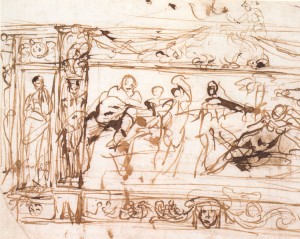Good discussion for my caricature post. I ended up saying stuff in comments about the Carracci, who are sometimes thought to have been the first portrait caricaturists. They taught quick-draw caricature, as an exercise, in their academy.
I don’t really go for all that “The Loves of the Gods” jazz. (It’s nice and all … if you like that sort of thing.) So I was very pleasantly surprised to discover just how much I like Annibale’s drawings. This book – The Drawings of Annibale Carracci – is amazing!
In spite of Annibale’s meticulous care in drawing realistically described and articulated forms, what sets him apart and places him in the category of great graphic artists is his ability to set down a few strokes to imply an entire scene … No one before Annibale, and only Rembrandt after him surpassed his genius for subtle suggestion.
So very true! Here, for example, is a preliminary sketch for the “Triumph of Bacchus and Ariadne” panel.
I guess they told him he couldn’t include Batwoman like that. DC would have sued.
Anyway, I don’t think I’ve seen, earlier, such a loose, abstract style of gesture drawing, as a way of working out a composition. Probably that is just my ignorance of the history of drawing, but this book really got me interested in Baroque painting, in an archeological sense: all the different layers of cartoon behind it, from the very rough to the very tight. Neat stuff, I say.

{ 8 comments }
Harold 06.09.14 at 1:22 pm
Thank you for this head’s up — and the whole stimulating discussion. I am going to try to get hold of this book. This was is not much emphasized in Art History class, at least when I went to school — in the stone age. My first thought is that the counter-reformation could not have been such a happy period, politically or economically — and it only got worse. One wonders how creativity survived under these conditions?
Re: the last thread. Here (in case people missed it) is a link to a caricature by Bernini, who worked in Rome a generation after Carracci: http://kateloughran.files.wordpress.com/2013/04/caricature_of_innocent_xi1323287494427.jpg
As to why the sketch is more lifelike than the finished product — I think the natural way — in human perception — that the brain of the spectator works actively in filling in missing details may have something to do with it. In a “finished” product there is less for the brain of the spectator to do. Less to “see”– paradoxically.
Anon 06.09.14 at 3:30 pm
The quoted bit about an entire scene conveyed in a few strokes reminds me of these first century mosaics from a villa in Rome. I wouldn’t call them caricature, but I think they display many of the virtues of an excellent cartoonist — a minimum of lines, the appearance of loose, casual drawing, but producing amazingly vivid, lifelike, and expressive, evoking an entire environment, narrative, and world.
https://www.flickr.com/photos/124499628@N05/14379799561/
https://www.flickr.com/photos/124499628@N05/14383135405/
https://www.flickr.com/photos/124499628@N05/14383139065/
dr ngo 06.09.14 at 5:43 pm
The first of “Anon’s” linked sketches immediately called to my mind Picasso’s Don Quixote: https://www.google.com/search?client=firefox-a&rls=org.mozilla:en-US:official&channel=sb&tbm=isch&imgil=79dsWt2TSxEUDM%253A%253Bhttps%253A%252F%252Fencrypted-tbn0.gstatic.com%252Fimages%253Fq%253Dtbn%253AANd9GcR2uUXX6CMxnKvWN8XGAspX5pMCJYq4arHdFT1IKpo7weqAGsNT%253B507%253B601%253BQFpqgSDqauhh2M%253Bhttp%25253A%25252F%25252Fen.wikipedia.org%25252Fwiki%25252FDon_Quixote_%28Picasso%29&source=iu&usg=__j4tBc0zj_jQpr8Zi3qcXBErWK2c%3D&sa=X&ei=wvGVU_PWBNWeyASR6IKoAw&ved=0CCwQ9QEwAQ&biw=1703&bih=931&q=don%20quixote%20illustrations%20picasso#facrc=_&imgrc=79dsWt2TSxEUDM%253A%3BQFpqgSDqauhh2M%3Bhttp%253A%252F%252Fupload.wikimedia.org%252Fwikipedia%252Fen%252F5%252F5f%252FDonquixote.JPG%3Bhttp%253A%252F%252Fen.wikipedia.org%252Fwiki%252FDon_Quixote_%28Picasso%29%3B507%3B601
PJW 06.11.14 at 2:08 am
My wife and daughter both have degrees in art and I recall both of them mentioning the quick-draw caricature exercise as part of their training. So it’s apparently still in use. As for the few strokes evoking the thing or whatever, I always think of a Picasso line drawing I saw in the late 1970s hanging on the wall of my friend’s older brother’s dorm room wall at the University of Iowa: http://www.sarahannsmith.com/weblog/wp-content/uploads/2007/12/picassofemme.jpg
Harold 06.11.14 at 1:57 pm
I thought it was Picasso, too, at first. There is something exhilarating in these drawings — the feeling of motion that is reminiscent of dance — I think very sophisticated Chinese drawings may have something of this quality, too. In the previous thread some mentioned cave art as well.
Carracci’s finished paintings appear quite static, in contrast, at least from what one can tell from the reproductions.
Harold 06.11.14 at 2:14 pm
Zero Mostel to Studs Terkel on Pollack and Ensor (at 26 ), gesture, clarity, and economy. “The mere fact that art is from the hand and mind is a remarkable thing”.
https://archive.org/details/popuparchive-1856624
des von bladet 06.11.14 at 5:36 pm
It was while I was watching Waldemar Januszczak’s series on the Baroque — by which he meant painting with a little architecture mixed in — and his remarks on the church ceiling painting as a narrative form that I came up with the idea for my best-selling art-history rant The Sistine Chapel Ceiling Considered As A Brilliant But Ultimately Unsuccessful Attempt To Invent The Comic Strip.
Harold 06.11.14 at 8:18 pm
Re: the Sistine Chaple: The Roman catholic church endorsed the idea of visual art as a form of rhetoric (see “Poor Man’s Bible” entry at wikipedia, for example).as a response to the various iconoclastic controversies and to differentiate itself from the Greek church, which on the other hand defended (two-dimensional) painting a means of direct communication with the divine (icons). I suppose both were responding to Islamic iconoclasm. At the time of the Counter Reformation, when Annibale Carracci was painting his Farnese ceiling, the church was doubling down on affirmation of the use of images as rhetoric to promote the faith, this time in response to the challenge of Protestant iconoclasm.
But the tradition of combining popular narrative with painting is a very ancient and vibrant folk tradition that goes back to India and was practiced from China and Japan to Spain and Belgium and Germany, see for example, Victor Mair’s wonderful book on painting and performance in China: http://books.google.com/books/about/Painting_and_Performance.html?id=aNVFPgAACAAJ
In Sicily, as late as post WW 2, Orazio Strano, the last of the “cantastorie”, illustrated his topical ballads with series of paintings. His performance and artwork of the ballad of the bandit Salvatore Giuliano can be seen on youtube. I think Victor Mair mentions him in his book on performance.
Comments on this entry are closed.